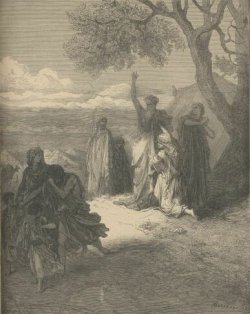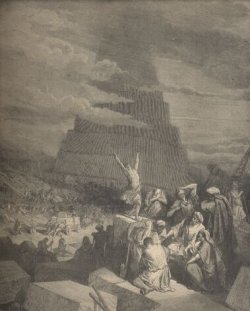Genesis 9, 10

Noah Cursing Ham by Gustav Dore
The account of Noah’s “nakedness” and the role his sons played in the event is a puzzling one, especially the part in which Noah awakens and pronounces a curse upon Canaan, the son of Ham, who does not even seem to be present at the time. Genesis 9:20-27 reads,
“And Noah began to be an husbandman, and he planted a vineyard: And he drank of the wine, and was drunken; and he was uncovered within his tent. And Ham, the father of Canaan, saw the nakedness of his father, and told his two brethren without. And Shem and Japheth took a garment, and laid it upon both their shoulders, and went backward, and covered the nakedness of their father; and their faces were backward, and they saw not their father’s nakedness. And Noah awoke from his wine, and knew what his younger son had done unto him. And he said, Cursed be Canaan; a servant of servants shall he be unto his brethren.
And he said, Blessed be the LordGod of Shem; and Canaan shall be his servant. God shall enlarge Japheth, and he shall dwell in the tents of Shem; and Canaan shall be his servant.
Most members of the Church are aware that a priesthood garment, symbolic of the covenants made in the temple, is worn by those who have participated in the endowment ceremony in the temple. This garment is a representation of the coat of skins made by the Lord for Adam and Eve after the Fall (see Genesis 3:21 ; Moses 4:27 ). The idea of a garment made of skins that signified that one had power in the priesthood is found in several ancient writings. Hugh Nibley discussed some of these ancient writings and their implications for the passage in Genesis:
“Nimrod claimed his kingship on the ground of victory over his enemies [see Genesis 10:8–10 ; Reading 4-21 ]; his priesthood, however, he claimed by virtue of possessing ‘the garment of Adam.’ The Talmud assures us that it was by virtue of owning this garment that Nimrod was able to claim power to rule over the whole earth, and that he sat in his tower while men came and worshiped him. The Apocryphal writers, Jewish and Christian, have a good deal to say about this garment. To quote one of them: ‘the garments of skin which God made for Adam and his wife when they went out of the garden and were given after the death of Adam . . . to Enoch’; hence they passed to Methuselah, and then to Noah, from whom Ham stole them as the people were leaving the ark. Ham’s grandson Nimrod obtained them from his father Cush. As for the legitimate inheritance of this clothing, a very old fragment recently discovered says that Michael ‘disrobed Enoch of his earthly garments, and put on him his angelic clothing,’ taking him into the presence of God. . . .
“Incidentally the story of the stolen garment as told by the rabbis, including the great Eleazer, calls for an entirely different rendering of the strange story in Genesis from the version in our King James Bible. They seemed to think that the ’erwath of Genesis [9:22] did not mean ‘nakedness’ at all, but should be given its primary root meaning of ‘skin covering.’ Read thus, we are to understand that Ham took the garment of his father while he was sleeping and showed it to his brethren, Shem and Japheth, who took a pattern or copy of it (salmah) or else a woven garment like it (simlah) which they put upon their own shoulders, returning the skin garment to their father. Upon awaking, Noah recognized the priesthood of two sons but cursed the son who tried to rob him of his garment.” ( Lehi in the Desert and the World of Jaredites, pp. 160–62.)
Therefore, although Ham himself had the right to the priesthood, Canaan, his son, did not. Ham had married Egyptus, a descendant of Cain ( Abraham 1:21–24 ), and so his sons were denied the priesthood.
The story of Ham and Egyptus is entirely unknown to anyone who is unfamiliar with the Book of Abraham in the Pearl of Great Price:
“Now this king of Egypt was a descendant from the loins of Ham, and was a partaker of the blood of the Canaanites by birth. From this descent sprang all the Egyptians, and thus the blood of the Canaanites was preserved in the land. The land of Egypt being first discovered by a woman, who was the daughter of Ham, and the daughter of Egyptus, which in the Chaldean signifies Egypt, which signifies that which is forbidden; When this woman discovered the land it was under water, who afterward settled her sons in it; and thus, from Ham, sprang that race which preserved the curse in the land.
The Founding of Babylon

Tower of Babel by Gustav Dore
Nimrod was a mighty hunter. The Joseph Smith translation of the Bible says that he was a mighty hunter in the land, whereas Genesis says he was a mighty hunter in the Lord. His name comes from the Hebrew word marad, which means, “he rebelled.” The Jerusalem Targum explains, “Nimrod began to be a mighty man in sin, a murderer of innocent men, and a rebel before the Lord.” Nimrod said to his followers, “Depart from the religion of Shem, and cleave to the institutes of Nimrod.” The Syriac calls him a warlike giant. The word . . . tsayid, which we render hunter, signifies prey; and is applied in the scriptures to the hunting of men by persecution, oppression, and tyranny. Hence it is likely that Nimrod, having acquired power, used it in tyranny and oppression; and by rapine and violence founded that domination which was the first distinguished by the name of a kingdom on the face of the earth.” (Clarke, Bible Commentary, 1:86.)
Thus, in the same patriarchal age, Melchizedek established a Zion after the pattern of Enoch, the prototype of the true city of God, the freest of all societies, and Nimrod established a Babylon that gave its name to the prototype of the kingdom of Satan, the antithesis of Zion (see Nibley, Lehi in the Desert, pp. 154–64).
The Tower of Babel
Remember that Enoch’s city was taken up into heaven before the flood, and the people who lived after the flood would have a record of that. Nimrod decided to build a tower from which to war with the population of heaven. If he knew of the City of Enoch, that would make this a more tangible goal. The project was an example of Nimrod’s unmitigated pride and rebellion. The Lord destroyed the Tower of Babel. The Book of Jasher has an interesting comment on the result of the destruction. It says that 1/3 the people had their language confounded; 1/3 were destroyed; and 1/3 became ape-like.
The Book of Mormon talks about a group of people who were among those whose language was confounded. The main body of the Book of Mormonpeoples in the Americas were called the Nephites, and it was they who kept the record. However, they happened upon the ruins of a previously destroyed people. A record was left by these people, and it was translated by a Book of Mormon prophet who had the Urim and Thummim, used by seers to translate. The record was written on 24 metal plates and recorded by the prophet Ether.
“Jared came forth with his brother and their families, with some others and their families, from the great tower, at the time the Lord confounded the language of the people, and swore in his wrath that they should be scattered upon all the face of the earth; and according to the word of the Lord the people were scattered.
